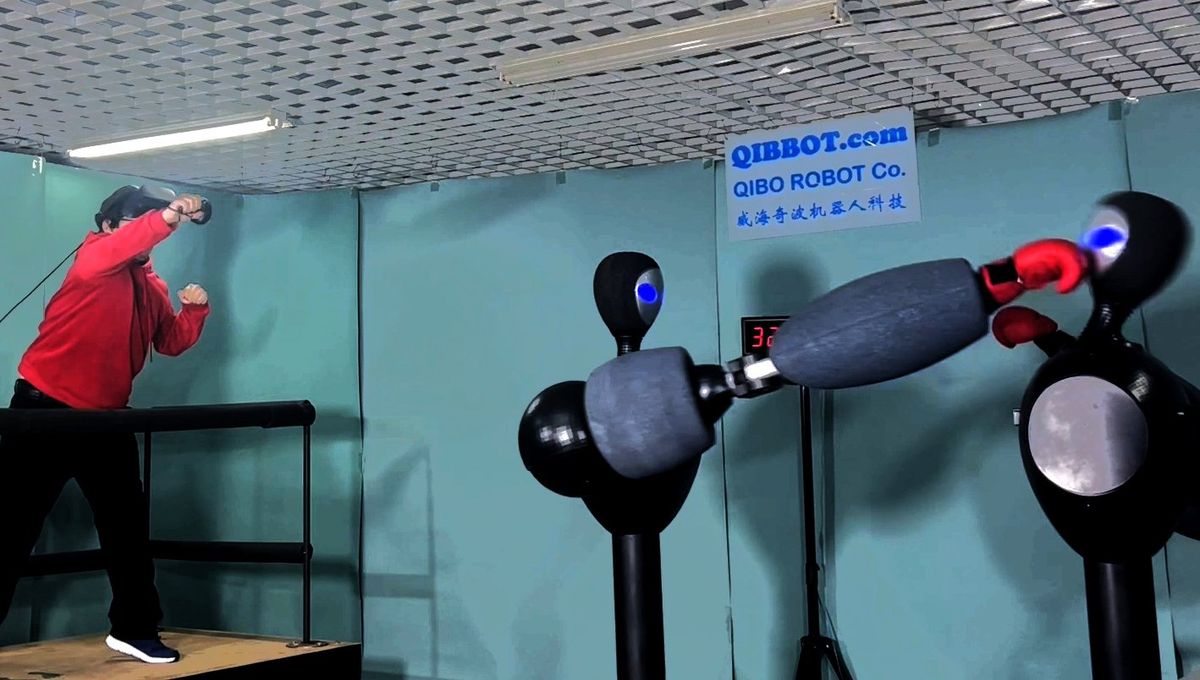During the final fight scene of the 2011 film Real Steel, two giant robots battle it out in a boxing ring—and the underdog is losing. Before the final round, Hugh Jackman’s character, Charlie, takes his robot aside and tells it to watch him and follow his lead from the sidelines.
The final round commences, Charlie puts his guard up, and—at just the right moment—throws a mean uppercut. His robot mimics the same motion in the ring, rocking the bigger robot hard. The pair then unleash a flurry of punches against their opponent in an epic comeback before the round ends, just before the underdog can complete the knockout.
Inspired by this scene, researchers have created a similar teleoperated robot, called QIBBOT, that mimics the real movements of a human fighter. And not only can this robot pack a punch, it does so with unprecedented speed. With a latency of just 12 milliseconds, it is likely the fastest teleoperated robot created to date, its creators claim.
The researchers then put QIBBOT to the test—against an AI-guided opponent that learns and adapts while it fights. You can watch the battle here:
World’s Fastest Tele-Robot [Big Robot for Fighting Game with VR Controller: QIBBOT]Qibo Robot Company
Yining (James) Geng is the CEO of Qibo Robot Co. in Weihai, China, which led the development of QIBBOT. “Taking inspiration from the film [“Real Steel”] and incentivized by the entertainment value, we decided to see if we can realize the concept of real-life fighting robots,” he says. “We thought players’ experience with big and real robots would be very new and different from computer games.”
Several different teleoperated robots already exist, but these have completely different purposes, and most tend to be small and only move at slow or medium speeds. “Fast speed is the first priority of fighting robots,” Geng says.
With teleoperated robots, there are a lot of different aspects that factor into their speed, including communication, interface, actuation, transmission, the controller, and computation.
To help QIBBOT achieve high speeds, Geng’s team focused on addressing issues related to the robot’s mechanics and controller. They first built an accurate kinematics and dynamics model, which they used to optimize QIBBOT’s mass distribution, mechanical structure, actuation, and communications. Then, in addition to using a conventional feedback controller that works reactively, they designed a new feedforward controller, which proactively responds to the motion commands from the VR controller. This approach cancels some of the latency caused by other components in the system, according to Geng.
To create a formidable robot opponent that is guided by AI, Geng and his colleagues combined several different existing AI programs. Collectively, these programs help the autonomous AI-guided opponent distinguish between attack and defense, generate fighting strategies, and reference a library of data on the parameters for specific fighting scenarios. As seen in the video above, the AI opponent can learn moves while in the midst of a fight with the robot guided by Geng.
While the battle is entertaining and undoubtedly looks fun, there are still some aspects of QIBBOT that need to be addressed.
“We optimized the mechanical system design of QIBBOT for fast response, and that has a price—the accuracy,” says Geng. He notes that although accuracy may not matter as much in a fight scenario, it would be important if this tech was adapted for other purposes.
He says QIBBOT is just a prototype for testing the design and controller. “It has some problems, like unwanted vibration, unnatural motion styles, et cetera. We are designing a new robot that will have dual arms and more joints in the body and arms, and will solve these problems.”
Michelle Hampson is a freelance writer based in Halifax. She frequently contributes to Spectrum's Journal Watch coverage, which highlights newsworthy studies published in IEEE journals.



